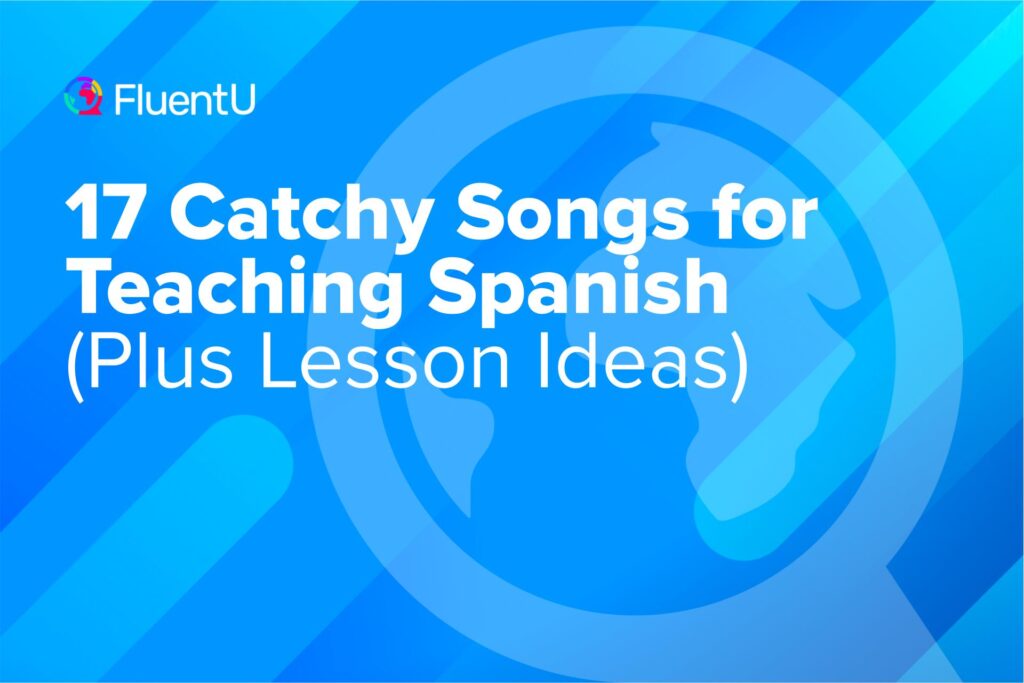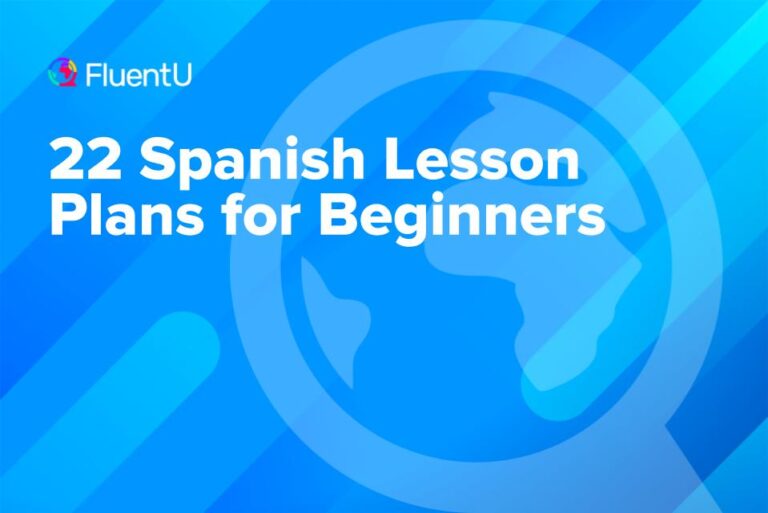Contents
- 1. “Me gustas tú,” Manu Chao
- 2. “Inevitable,” Shakira
- 3. “¿Qué sera?,” Amaral
- 4. “Si Pudiera,” Los Suaves
- 5. “Malo,” Bebe
- 6. “La Reina del Pop,” La Oreja de Van Gogh
- 7. “Aquellos años locos,” El Canto del Loco
- 8. “Marta, Sebas, Guille y los demás,” Amaral
- 9. “Ser o estar,” Jesse y Joy
- 10. “Hace tiempo,” Fonseca
- 11. “Limón y sal,” Julieta Venegas
- 12. “Pobre Juan,” Maná
- 13. “Tu fotografía,” Gloria Estefan
- 14. “Un beso y una flor,” Nino Bravo
- 15. “No que no,” Cañaveral
- 16. “¿Qué hiciste?,” Jennifer López
- 17. “No es lo mismo,” Alejandro Sanz
- Activities for Teaching Spanish with Songs
- Why Use Songs for Teaching Spanish
17 Catchy Songs for Teaching Spanish (Plus Lesson Ideas)

Bringing authentic Spanish language music into your classroom can liven it up and give students a creative and relaxing way to learn. It’s a great juxtaposition to the more formal lessons like grammar, verb conjugation and vocabulary.
I’ve used music in my Spanish classroom for years with excellent results. Students love listening to music and I get the satisfaction of knowing I’m not only teaching them the language, I’m giving them insight into Spanish language culture.
Here are my top 17 top pick songs for Spanish class, complete with grammar points and teaching ideas for each song, along with videos.
Download: This blog post is available as a convenient and portable PDF that you can take anywhere. Click here to get a copy. (Download)
1. “Me gustas tú,” Manu Chao
Difficulty: Beginner
“Me gustas tú” is Manu Chao’s most popular song, a catchy tune that will ensure your students master opinions once and for all. Anyone that has already listened to Manu Chao’s hit will surely agree that it does its work when it comes to drilling likes and dislikes, because the song repeats the common Spanish phrase me gusta (I like) over and over in each verse.
Check out this safe version of “Me gustas tú” if you teach younger students, as the original does mention marijuana.
Lesson ideas
You could organize a survey for your students. Give your students a list of vocabulary from the song (el café, correr, la cena, la noche…) and ask them to go around and ask each other “¿Te gusta…?”
Higher-ability students can extend their learning by including reasons and aiming for more complex forms, while lower-ability students can have visual or written support (for example, model questions and answers) to help them get involved in the activity.
Surveys are really successful group activities because they are not only fantastic speaking practice, but also a great way to break up the routine, get your students walking around and working independently, without having to constantly follow your guidance.
This template for surveys is really accessible for younger students.
2. “Inevitable,” Shakira
Difficulty: Intermediate
Although our students will probably know (and love) some of the newer Shakira songs, older tunes like “Inevitable” are still fresh and great for teaching. “Inevitable” is fantastic for focusing on the present tense, as most of the song is made of simple, straightforward sentences. Plus, the vocabulary is varied, but quite accessible.
Lesson ideas
“Inevitable” includes many verbs in the present tense, including irregular verbs. Additionally, there are a few verbs in the past and the future tenses too. This offers great scope for differentiation, allowing higher-ability students to tackle harder verbs, while lower-ability students can work with simpler forms.
Allow your students to work with a conjugator app like VerbTrainer to check their answers and find the ones that they can’t wok out (i.e. conocer – conozco). Remember, with Spanish it’s not always about having every answer, but also about knowing where to find them!
I’m a firm believer in the benefits of practice and using the right resources when it comes to verb conjugations. “Inevitable” is a fantastic way to reinforce verbs in a more entertaining way.
3. “¿Qué sera?,” Amaral
Difficulty: Intermediate
At an advanced level, our students are able to play with the language in a more natural way and need resources that are able to stretch them. Music at this level plays a different role, moving away from the usual listening comprehension and showing our students the particularities of different dialects and slangs.
Lesson ideas
You can reinforce the new vocabulary by asking your students to describe famous people or popular TV characters with the phrases that were taught in class.
So, why not make it even better by actually watching an episode (or part of it) of a popular Spanish TV series, such as “Cuentame” or “El Ministerio del Tiempo” (which can be watched online via the RTVE website) and using the vocabulary to describe the characters and situations? For example, “En este episodio, Toni es un Don Juan” or “Amelia es un trozo de pan.” Now that’s real Spanish immersion!
4. “Si Pudiera,” Los Suaves
Difficulty: Intermediate
Do you want to rock your lesson with the best tunes? If you’re looking for some good old rock classic, then Los Suaves is a must-have in your music collection.
Grammar can be boring, especially when you’ve been doing the same exercises year after year. Trust me, I’m still battling with some of those when I go to my French lesson (yeah, I’m still a language student too…). Don’t get me wrong, they’re really useful, but for once I just wished my teacher would come up with something different!
Lesson ideas
Some years ago, Yosi was diagnosed with hepatitis, which has forced the band to retire. Get your students to read this article on Los Suaves’s announcement and then work in pairs preparing the interview, with a focus on what would happen if Yosi wasn’t ill or what he would do if he could keep playing for years…
By providing your advanced level students with a magazine article and a real scenario, you’re giving them the opportunity to use the language with a real purpose.
5. “Malo,” Bebe
Difficulty: Intermediate
“Malo” is a tale about one of the biggest social problems in Spain: domestic violence. What in Bebe’s song is just a sad story, is actually a real drama in Spain today.
Lesson ideas
RedEle’s magazine features a great didactic session on gender violence, which not only explores the message behind the song, but helps students analyze the whole situation. Although there’s not a huge deal of grammatical content covered in this unit, when it comes to cultural awareness, it doesn’t get any better than this. There are graphs to analyze and key data and information on gender violence in the target language, which will enable us to take our lesson a step further.
The ultimate objective with our advanced level classes is to be able to have a debate on the topic, in which students use the language to communicate in the most natural way possible. So, combine this song and unit with a recent newspaper article covering the impact of domestic violence in one of the Spanish-speaking countries to trigger that debate! Go to El País or El Mundo, search for “violencia de genero” and find the perfect article to get your class babbling away.
6. “La Reina del Pop,” La Oreja de Van Gogh
Difficulty: Advanced
“La Reina del Pop” is one of the La Oreja de Van Gogh’s first songs, and yet another great way to practice the present tense—a key grammar point for beginners.
Lesson ideas
Experience has taught me that Spanish learners find the tú form and the vosotros form the hardest to memorize, probably because our focus on writing activities gives them fewer possibilities to practice them. For English speakers, the tú and vosotros forms come with the additional complication of not having a clear difference between “you singular” and “you plural” in their native language.
Take advantage of this opportunity to reinforce the differences between “you singular” and “you plural” in Spanish. Using the lyrics, ask students to identify verbs in the tú form and change them into the vosotros form, maybe as a pair activity or even as a whole class. How would the sentence change in English? How would the meaning change?
7. “Aquellos años locos,” El Canto del Loco
Difficulty: Advanced
Once students are comfortable using the present tense and verbs conjugations, the next step is being able to master other tenses.
Although the grammar practice opportunities in this song make it a great choice for our lessons, there’s much more to it than just verb conjugations.
“Aquellos años locos” is the story of someone’s youth, so students can take a stroll down history lane to discover what life was like in Spain during the ’80s.
Lesson ideas
Hands up if you teach the imperfect by getting students to talk about their childhood. I see many hands out there, including my own. So what better way to do it than with this song? After listening and working with the lyrics, Oscar’s lesson plan features an exercise in which students describe their own youth and even compare it with that of their partners.
To show a better command of the Spanish language, get your students to compare their life as kids to their lives now, by combining the imperfect and the present tense—just as you can see on the final slide of this PowerPoint, which will help you teach this new tense. Even better, use this as a way to compare how life has changed in their own country and in Spain since they were younger.
8. “Marta, Sebas, Guille y los demás,” Amaral
Difficulty: Advanced
The great thing about teaching Spanish to an intermediate class is that, at this level, students are already able to hold small debates and express their own views on different topics. “Marta, Sebas, Guille y los demás” is a song about friendship, an accessible topic for pupils of different ages and something they surely have loads to say about!
“Marta, Sebas, Guille y los demás” also provides great grammar practice. The whole song is pretty much a combination of preterite and imperfect tense, giving us fantastic opportunities to work with these two tenses together once our students are comfortable conjugating them separately.
Lesson ideas
You can reinforce the new vocabulary by asking your students to describe famous people or popular TV characters with the phrases that were taught in class.
So, why not make it even better by actually watching an episode (or part of it) of a popular Spanish TV series, such as “Cuentame” or “El Ministerio del Tiempo” (which can be watched online via the RTVE website) and using the vocabulary to describe the characters and situations? For example, “En este episodio, Toni es un Don Juan” or “Amelia es un trozo de pan.” Now that’s real Spanish immersion!
If you have higher-ability students in your class that could cope with some challenge, you can ask them to predict what will happen to their friendships in the future. Especially for those in school, it would be a great way to review vocabulary regarding future plans.
9. “Ser o estar,” Jesse y Joy
Difficulty: Beginner
“Ser o estar” by Mexican singers Jesse y Joy is a great choice for helping students learn the differences between the verbs ser and estar. The title says it all! You might pass out the lyrics with the verbs ser and estar erased and have students fill in the correct verbs before listening to the song to check answers.
No quiero estar si tú no estás aquí
No entiendo lo que siento
Cómo pensar en dejarte ir
Si digo que no importa, miento
Se empieza a notar si tú no estás
En mi comportamiento
10. “Hace tiempo,” Fonseca
Difficulty: Intermediate
In addition to incorporating daily routine vocabulary and reflexive verbs, “Hace tiempo” by the Colombian singer Fonseca is great for practicing irregular verbs, which you might have students go through and identify before listening to the lyrics. Check out all the irregulars here!
De hace tiempo que te digo que yo siento
Que me muero, no es tan fácil vivir lejos
De la mujer que yo quiero
Aún me queda tu recuerdo enmarcado en el espejo
11. “Limón y sal,” Julieta Venegas
Difficulty: Intermediate
The song “Limón y sal” by Mexican singer Julieta Venegas was a big hit, and it’s sure to be a hit with your Spanish classes as well. Look at all the regular and irregular verbs in the chorus! Consider having students identify the regular and irregular verbs before listening to the song.
Yo te quiero con limón y sal, yo te quiero tal
Y como estás, no hace falta cambiarte nada
Yo te quiero si vienes o si vas, si subes
Y bajas, si no estás seguro de lo que sientes
12. “Pobre Juan,” Maná
Difficulty: Intermediate
Although this song is quite sad, “Pobre Juan” by the Mexican rock group Maná has become a sort of teaching staple for comparing preterite and imperfect aspects of the past. Consider removing the verbs in the preterite and imperfect and replacing them with infinitives. Have students work in groups to read through the entire song and conjugate the verbs appropriately. Then, play the song and have students make corrections. Discuss why the verbs are in the preterite or imperfect.
Juan se lanzó marchándose al norte
Iba en busca de una vida digna
Cruzando México por valles y por montes
Iba Juan lleno de fe
La historia es que Juan se iba a casar
Con María embarazada
Pero él no tenía ni un centavo
Ni un clavo que darle
13. “Tu fotografía,” Gloria Estefan
Difficulty: Intermediate
A staple of music in Spanish, Cuban singer Gloria Estefan’s 2003 hit “Tu fotografía” is also sure to get students interested in conjugating verbs.
Cada día que pasa te pienso y te vuelvo a mirar
Cada cosa en su sitio, el pasado, el presente
En el polvo mis dedos se juntan
Y quiero tenerte cambiando conmigo
No he movido tu foto ni el tiempo en los años
Si me hablas de lejos procura avisarme temprano
Y así imaginarme
Que te tengo aquí…
14. “Un beso y una flor,” Nino Bravo
Difficulty: Intermediate
An oldie but goodie, Spanish pop singer Nino Bravo’s “Un beso y una flor” does future like a boss. For this song, try having students listen to the song without lyrics and writing down all the uses of future that they hear.
Dejaré mi tierra por ti, dejaré mis campos y me iré
Lejos de aquí
Cruzaré llorando el jardín y con tus recuerdos partiré
Lejos de aquí
De día viviré pensando en tu sonrisa
De noche las estrellas me acompañarán
Serás como un luz que alumbra en mi destino
Me voy pero te juro que mañana volveré
15. “No que no,” Cañaveral
Difficulty: Intermediate
The song “No que no” by Mexican group Cañaveral is great for helping students get used to hearing the future tense. It’s a more difficult song lyrics-wise, but the chorus is catchy. You might have students memorize the chorus to get used to how the future tense sounds and is conjugated.
Llorarás y sufrirás
Pensando en mí
Vivirás y recordarás
Pensando en que no volveré
16. “¿Qué hiciste?,” Jennifer López
Difficulty: Advanced
For teaching past tense, you might have students listen to Jennifer López’s “¿Qué hiciste?” A good idea is to ask students to decide why the first set of lyrics are in the imperfect and the second in the preterite.
Ayer los dos soñábamos con un mundo perfecto
Ayer a nuestros labios les sobraban las palabras
Porque en los ojos nos espiábamos el alma
Y la verdad no vacilaba en tu mirada
Ayer nos prometimos conquistar el mundo entero
Ayer tú me juraste que este amor sería eterno
Porque una vez equivocarse es suficiente
Para aprender lo que es amar sinceramente
17. “No es lo mismo,” Alejandro Sanz
Difficulty: Advanced
A well-known hit by Spanish singer Alejandro Sanz, “No es lo mismo” also contains many examples of the verbs ser and estar. Since this song is a bit more difficult, you might pass out a sheet with lyrics and have students determine where ser is used and where estar is used. Then, have them decide why each verb has been used in each case.
No es lo mismo ser que estar
No es lo mismo estar que quedarse, ¡qué va!
Tampoco quedarse es igual que parar
No es lo mismo
Será que ni somos, ni estamos
Ni nos pensamos quedar
Pero es distinto conformarse o pelear
No es lo mismo…es distinto
Activities for Teaching Spanish with Songs
Opening Activity
Use a song as a way to get students to focus at the beginning of class. Using the lyrics to the song, you could ask students to complete a cloze activity while the song plays. This gives you a chance to take attendance, check homework and get set up for the day’s lesson.
Making Predictions
This activity works well for songs that have accompanying videos. After analyzing the song for a while, students can make predictions about how the video will portray the song. After making their predictions, students view the video and discuss (in Spanish) whether or not the video was what they thought it would be like.
Grab the Next Word
Using cards with words from the song written on them, students listen to the song until the music stops. At that point, they grab the next word that they would have heard in the song. This activity works especially well if you’re willing to sing the lyrics yourself. Sometimes, you can even get students to sing for you!
Lyrics Puzzles
Using cards with song lyrics written on them, students try to put the lyrics to a song in the correct order. You can modify the difficulty of this activity by putting phrases on some cards and single words on others. This is a good way to differentiate instruction.
Creating Stories
Give each student a line from the song you’re studying, and have them create a story based on those lyrics. This is a fun activity to do when beginning to learn a song, because the results will be diverse. After students have studied the song for a while, it can be interesting to go back and see the stories students created.
Sing-a-longs
Students can sing the song as a class, or they can have a sing-a-long competition. This is a great activity for days when your students have a lot of energy.
Dramatic Interpretations
Have students take on the roles of different characters in a song. They can act out what’s happening in real-time, create a skit or even make a music video to share with the class.
Why Use Songs for Teaching Spanish
I’m not looking to reinvent the wheel here when I speak about the wonders of music as a key part to everyone’s life, how it unites people, how it helps them express feelings and emotions, and provides an escape from the routine. There’s no denying music has a power beyond our understanding.
How can we use this power, though, to spice up our Spanish lessons and take them to a whole new level? What does music bring to language learning?
- Increases cultural awareness. Music gives students an understanding of the culture and society in Spanish-speaking countries. Whether that’s talking about previous conflicts, exploring the concerns that society has or just getting a peek into what daily life looks like in different places, it’s all valuable.
- Helps students understand different dialects. Although some might argue that this is, again, another cultural aspect of the language, the insight that music gives us into different Spanish dialects is so important, it just deserves a bullet point of its own. From Colombian slang to old-fashioned Spanish words, songs are a never-ending source of vocabulary and phrases to improve our students’ command of the language.
- Provides authentic materials. Songs are an obvious choice when it comes to using authentic materials, but Spanish music can also encourage students to regularly listen to the radio—increasing their love for the Spanish culture and providing us with hassle-free listening activities.
- Adds variety to how vocabulary is learned. Although there are new techniques and strategies that teach Spanish in different ways, the reality is that many of us are still using topic-based vocabulary activities. Sadly, our students become experts in talking about clothes, but are unable to hold a casual conversation with Spanish speakers. Songs provide a great way to teach new words in many different contexts, which will obviously benefit your students’ communication skills.
- Offers great scope for differentiation. There are plenty of activities that can be planned around songs, from your classic “fill in the blanks” to writing exercises or even debates. When it comes to planning activities around music, it becomes really easy to give our students different degrees of support without spending hours preparing our resources.
- Engages students and spices up lessons. No explanations needed, right? Just play your favorite tunes and get your students hitting the dance floor!
Now, to help your students gain all of these benefits, we’ve prepared a compilation of great “ready-to-go” lesson plans and activities based on popular Spanish songs.
And if you’re all about bringing songs and videos to the classroom, then you should check out FluentU.
Each clip comes with interactive subtitles that teach words in-context, so students can learn authentic Spanish while enjoying some awesome tunes. You can take advantage of FluentU’s diverse video library to integrate content from other media genres into your lesson plans.
FluentU works for the educator as well! FluentU’s integrated teaching tools make it simple to monitor your students’ progress as they complete exercises and review the newly-learned material.
Are you so excited about including music in your lessons that you’re ready to try them all? These 17 songs and ideas for teaching with music can totally rock your Spanish lessons this year!
Download: This blog post is available as a convenient and portable PDF that you can take anywhere. Click here to get a copy. (Download)







